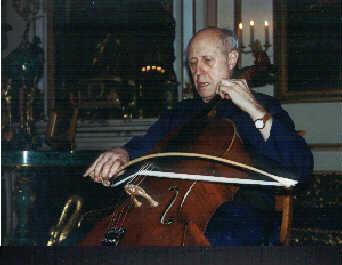
Photo used with permission of Renate Hoffleit © 1999

Photo used with permission of Renate Hoffleit © 1999
(The following is a transcript of a presentation on BACH.Bogen®)
Michael Bach: Bonjour Mesdames, Messieurs.
This is the BACH.Bow [BACH.Bogen®], a curved bow that makes polyphonic and monophonic play possible on a string instrument. There is a lever mechanism at the frog that affects the tension and release of the bow hairs.
I would like to start with a composition dedicated to Mstislav Rostropovich. The title is 3 Pitches, 21 Sounds. I wrote the piece in 1997 and the first performance took place in Jerusalem in 1998.
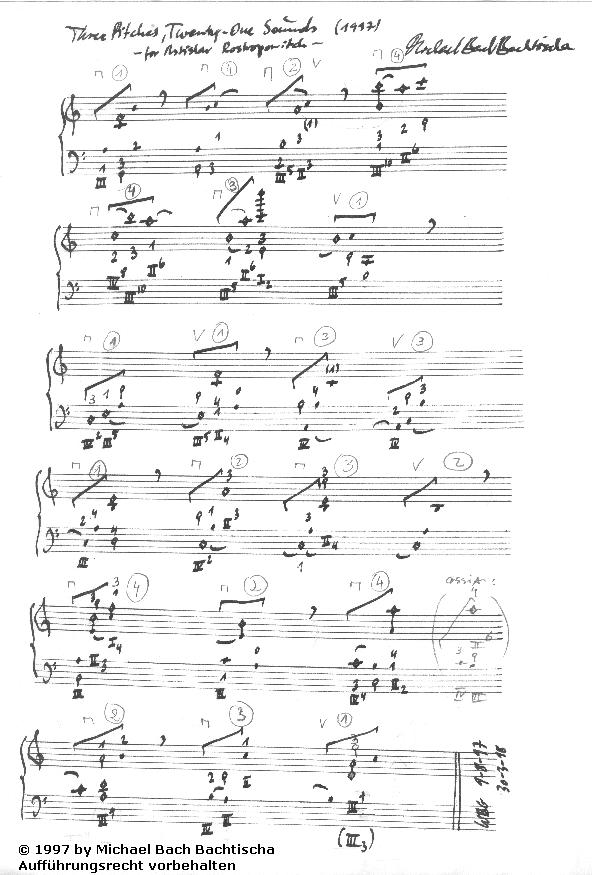
3 Pitches, 21 Sounds for Cello (Version 06102001)
As you have heard, I used only three pitches to compose this piece -- it is a birthday piece. There is a tradition when composing such a piece: one uses the letters in a name as a theme. It's easy with the name like "Sacher," but with Mstislav Rostropovich you are lost. [Laughter] I looked for "musical" letters in his name, because one cannot use the M -- I don't know which pitch that would be, and also the P,or the V.�
David Geringas: "Mi"
Michael Bach: OK, but what about the T? So, I decided to only make use of the A, H -- which is B in English, but in German it is an H -- and C. I also chose the French spelling of the name [Mstislav Rostropovitch] which has 21 letters, and I composed 21 chords out of these three pitches. Every chord is different, no chord repeats itself: this was my idea for Maestro Rostropovich.
As an aside, I would like to mention something that probably has nothing to do with the bow; I not only composed the piece, I created some visual artwork along with it, which I call "Fingerboards." [shows the Fingerboard 13 out of the series Fingerboards VI] These are prints on the cello, I made 21 of these boards, just like I used the 21 chords. They show the fingerings: I put them underneath the strings [demonstrates], and I take color. Then I print these boards with the pitches I play on the cello. So it's a choreography on the cello fingerboard with the pitches. Because I made both together, the visual art and the music, one could say I "composed" the boards and have "painted" the music. This connection between both works is important to me.
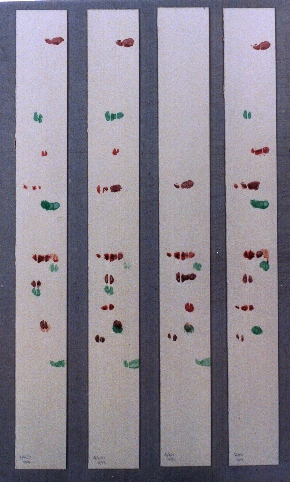
Fingerboards VI, No. 13-16
I am not the first to compose for the curved bow; John Cage was the first. I showed John Cage the curved bow in 1990 -- a very primitive version at that time -- and I played for him. He said, "Well, you have four times one string,
[Plays A, D, G, C]
three times two strings,
[Plays A+D, D+G, G+C]
two times three strings,
[Plays A+D+G, D+G+C]
and one times four strings."
[Plays A+D+G+C]
This is a very typical Cagian remark.
When we worked in New York one year later I had built two other bows, which were still very primitive. As you can see, they are curved differently: this one is for four strings and this one is for three strings.
At that time, I was not very concerned about the development of the curved bow, but more with the research on what I could finger with my left hand. It is also a question of the left hand: if you have four strings and five fingers there are many finger combinations possible on the cello, which I didn't fully understand at the beginning. In order to figure out the system behind all finger combinations I did some research, which is published in my book, Fingerboards & Overtones. In it I describe the polyphony on the cello with the left hand and the overtones,i.e. harmonics.
This research was very important when preparing the new cello work [by Cage], which is named ONE8 -- "one" means just a solo piece, and "8" means the 8th solo piece -- in this case for cello.
We have created, as an example, the following chord:
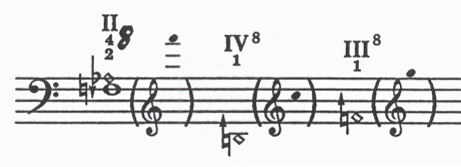
This is very complicated, it's the 8th partial of the C string, the 8th partial of the G string, and this pitch, an F on the D string. But this "F" is not played in this high position:
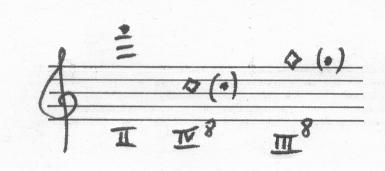
It is played in the first position, as the 8th partial of a fingered pitch; it is therefore an artificial harmonic. Traditional cello technique goes until the 6th partial but not the 8th.
I should also mention that at the beginning of the 20th century a vivid discussion arose about the curved bow: the spiritual father was Albert Schweitzer, who wrote a book about Johann Sebastian Bach in 1905. He demanded that it should be possible to play the chords on the violin, or the cello, just as they are written in the score. He thought, maybe, that such a curved bow had existed in Bach's time -- I've never seen one -- but it should be possible to play harmonic progressions like this:

Chord progression D - d
The German violinist, Rudolf Gähler, wrote a book about all the controversial texts concerning the curved bow for violin that were published since that time: Der Rundbogen für die Violine - ein Phantom? [The Curved Bow for the Violin -- a Phantom?] And he also recorded all Bach's Partitas and Sonatas for violin with a curved bow. There he demonstrated that it is, generally speaking, possible to play the score of Bach as it is written.
I myself think a little bit differently about this, I think that what is important is the flexibility, the richness of modulation that you can have with the curved bow:
[Plays Sarabande C-Major ... spontaneous applause]
[Plays Bourrée I C-Major ... applause]
I have designed the curved bow for contemporary music, but you can also play Johann Sebastian Bach with it.
In 1995 I was sure that it was worth the effort to improve the curved bow. (I still had the very primitive bows that I mentioned before.) I had built two other bows according to my own plans. One of these bows is this one [BACH.Bogen 5]. This bow made the acquaintance of Maestro Rostropovich. [to Mstislav Rostropovich] Do you remember?
This bow is too light, it's not a cello bow, actually, it's a violin bow. I had no other curved bow, so I used it. But at that time I already had plans to change and improve the curved bow.
Rostropovich and I met in 1997, but this was only the first encounter of many where we discussed new prototypes of the curved bow. I have some of them here:
[Michael Bach demonstrates and explains various curved bows: BACH.Bogen 1, BACH.Bogen 10, Prototype A, B, C, and D, BACH.Bogen 20, BACH.Bogen 30.]
The last curved bow that I showed you in Amsterdam earlier this year was this one [BACH.Bogen 34], which is even more ergonomic. One holds this bow in the hand like a conventional bow. It just needs the force to tighten the hairs, so one needs to strengthen some muscles. I showed this curved bow to you in Amsterdam, in June 2001, and then, we decided to present it to the cellists.
I don't know, is there anything you would like to say?
Mstislav Rostropovich: My dear friends, my dear colleagues, we also have history in our long life. When we changed the bow, changed a little bit the cello. Why do we change the bow, or an instrument? Because of the composers. They have another idea about the old material what we have: the bow, less the cello....
This notion of making a polyphonic bow, I think, is very interesting, and a great idea! But, how can we convince composers of this idea, of this new possibility for the cello? We need a new repertoire for the cello. My friend, who designed this new curved bow, also composes. But now he must influence another composer to write for these Neuigkeiten -- for this new development and idea. Only after composers start to write for the new curved bow will we better know how great this invention is.

| Direct correspondence to the appropriate ICS
Staff Webmaster: "webmaster" Director: John Michel Copyright © 1995- Internet Cello Society |
|---|